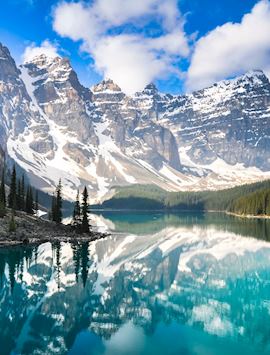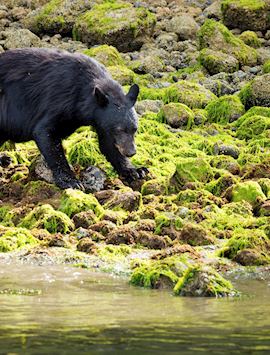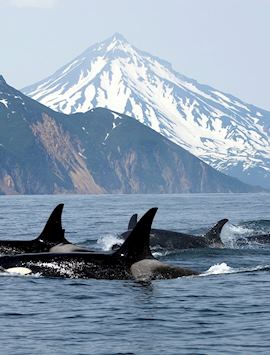By Canada specialist Rachel
Paddling across a sparkling bioluminescent bay, tracking the howls of wolves with a Tlatlasikwala guide, spotting your sixth grizzly bear of the day… British Columbia might be best known for iconic destinations like Vancouver and Whistler, but beyond the well-trodden path is a veritable menu of quieter experiences. Here, you can connect more deeply with Indigenous culture, enjoy unparalleled wildlife interactions, and venture where the roads don’t go.
To give you an idea of what this diverse landscape holds, I’d like to share the best places to explore that the crowds don’t know about yet. Ranging from secluded hiking routes to coastal rainforest and a remote bear sanctuary, they each offer a way to delve into the wilder side of Canada’s westernmost province.
1. Off-grid in the Kootenays

The call of Canada’s towering peaks leads many to the Albertan Rockies — in particular, Banff and Lake Louise. While both are well worth a visit, the large crowds drawn to these areas can make it harder for you to fully engage with the natural world. The Kootenays is a region nestled in southeastern British Columbia and is a quieter alternative peppered with mirror-smooth lakes, sloping cedar forests, and sheer, snow-capped mountains.
To get the full wilderness experience, I suggest making a beeline for Cross River Cabins. With no Wi-Fi, TV, or cellular service (except for emergencies), a stay here offers you a real chance to disconnect from the outer world.
Aside from that, the experience is what you make it. You could take the opportunity to relax by taking part in yoga, forest bathing, and waking to the delicate trill of hummingbirds. Or you might engage with some of the more high-energy activities, like white-water rafting, mountain climbing, guided hikes, and fishing.
The owners here are of Métis ancestry, so your stay at the cabins is also a valuable opportunity to learn about First Nations culture. The cabins are decorated with local First Nations motifs, and we can arrange for you to take part in immersive cultural experiences, from bow making and basket weaving to “uncomfortable history” hikes. These go into detail about the legacy of persecution faced by Indigenous Canadians in the region. As the name suggests, it’s not a light-hearted topic, but it is an eye-opening and invaluable learning experience.
Alternatively, if you’re just passing through the Kootenays, you might like to try out one of its many wilderness trails. There are plenty here of various difficulties, but my top choice would be the (wheelchair-friendly) boardwalk trail around Olive Lake, which shimmers a startingly bright emerald green in the August sun.
2. A road trip along the Sunshine Coast

When I lived in Whistler, the Sunshine Coast was my go-to spot for a road trip away from the hustle and bustle of ski-resort life. With its misty inlets, laidback communities, and fjord-like waters, this 177 km (110 mile) stretch along the Strait of Georgia is like a longer, tamer, lesser-trodden Tofino (a must-see stop on Vancouver Island).
I recommend starting in Langdale, at the coast’s southern tip. It’s only a 40-minute ferry ride from Vancouver’s Horseshoe Bay, and, from there, you can drive for 30 minutes along fir tree-lined coastal roads to Sechelt.
Home to a thriving art scene, Sechelt also has an adventurous edge. It borders the Salish Sea and is a great place for water sports. On its unruffled waters, I’ve known people see porpoises, sea lions, and even (in the case of one unprepared friend) a bright purple starfish that took a liking to a kayaking oar.
There’s also a wealth of hiking trails along the coast. I’m most partial to the Pender Hill Trail, near Irvines Landing. It’s fairly steep and involves a bit of scramble at the top, but it’s worth it for the views you’ll see looking down on Pender Harbour. Deep green thickets of needle-like trees fringe still blue waters.
However long your journey, I always suggest ending in Egmont, another hour’s journey north from Sechelt. This unassuming fishing village is a fantastic jumping off point for some of the best nature experiences on Canada’s West Coast.
I love the Princess Louisa Inlet Cruise — a voyage past thundering waterfalls and historical petroglyphs to a glacier-fed fjord bordered by rainforest. Or, for something entirely different, you could join a night kayaking tour of Sechelt Bay, which glows with bioluminescence under moonlight.
If you wish to stay overnight, you can’t get any better than the waterfront West Coast Wilderness Lodge for more vistas of placid waters and densely wooded inlets to enjoy as you rest.
3. Hikes into old-growth forests around Port Renfrew

Vast tracts of mossy old-growth forest. Meandering shorelines strewn with driftwood. Shallow pools brimming with intertidal critters. This is the scenery that attracts so many to Vancouver Island’s wilds. Most head to the sky-scraping rainforests of Tofino or stop by Campbell River — the alleged salmon capital of the world — but, in my opinion, tranquil Port Renfrew on the island’s southwest coast is equally worthy of a visit.
Just a two-hour drive from Victoria, this fishing outpost is ideal for those who have only a day or two on the island. The atmosphere here is pure rustic, with just a few lodges (including lovely Wild Renfrew Seaside Cottages) and stores dotting the shoreland. The rest of the landscape gives way to gnarly old-growth forests.
Indeed, forests are the main attraction here. This is nicknamed the “tall tree capital of Canada”. Check out the San Juan Spruce, which is the tallest spruce tree in Canada (and one of the tallest in the world). On the other end of the scale, there’s the Fairy Lake fir, a tiny sprouting that grows out of a log on Fairy Lake — a view reminiscent of a bonsai display.
It’s also worth walking a chunk of the Juan de Fuca Marine Trail. The full trail takes at least three days and requires a good level of experience, but even if you’ve got young children, you can navigate the shorter section down by Botanical Beach. This area is replete with sea life at low tide. Sea cucumbers, star fish, sea urchins, and gooseneck barnacles pile up like jewels within the tidal pools, and whole squads of orcas have been seen flipping in and out of the sea waters during the summer months.
For somewhere the locals like to go, you could drive over to Sooke Potholes Provincial Park, an hour’s north of Port Renfrew. Here, you’ll find more tidal pools — but these ones are a little different: deep smooth potholes carved into the bedrock of Sooke River.
4. Art & wine tasting in the Gulf Islands

When I visit somewhere as large as British Columbia, I always try to source its tinier islands and see what unique personalities they hold. The Gulf Islands, situated in the Strait of Georgia, don’t disappoint. Their artsy, laissez-faire character is a world apart from the mainland.
Salt Spring Island is the largest and easiest to reach of these islands. You can get here in about 90 minutes by ferry from Tsawwassen, near Vancouver. Or, if your inner explorer is calling, take a 45-minute seaplane into Ganges Harbour.
The island has gained a reputation as somewhat of an artists’ commune, and it’s worth stopping by a gallery or two while you’re here. There’s even a self-guided Salt Spring Studio Tour. However, what I like most about the Salt Spring’s art scene is how locally inspired it is. There’s no better place to see that than at the Centennial Park farmers’ markets, where you can browse eclectic trinkets and blankets along with locally made cheeses, wines, and ciders.
Thanks to its long agricultural history, farming culture is also massive here, and if you’re into learning about food communities there’s a culinary tour I particularly like. Following a passionate islander around wineries, a cidery, a brewery, a distillery, and a cheesemonger, you’ll learn about each vendors’ processes while sampling their flagship products.
If you’re more of an outdoor adventurer, there’s also plenty of hiking opportunities on Salt Spring Island, such as the trail up Mount Maxwell, where you’re surrounded by soaring Douglas fir trees.
If you’re looking to get even further off grid, I advise taking the ferry over to one of less populated islands. I’m a big fan of Mayne Island, which has some of the most diverse forests in the Gulf Islands National Park Reserve — and more deer than you’ll probably ever see in your life. There’s also Galiano Island, where you can explore white shell beaches and uniquely eroded sandstone caves.
5. Coastal rainforest walks & wildlife in Port Hardy

Sitting at the northwest tip of Vancouver Island, Port Hardy is best known as a gateway into the Great Bear Rainforest. But it’s a mistake to only pass through here. This fishing hub is a window into the island’s somehow wilder north, with a strong Indigenous presence, a coastal rainforest dense with velvety moss, and a rich diversity of wildlife, even for British Columbia.
Though the hinterlands are the main attraction here, you’d be remiss not to spend an hour or two in town. It’s located in traditional Kwakwa̱ka̱ʼwakw territory, so there’s a wealth of First Nations iconography to see. I really like walking down to see Carrot Park’s totem poles, and for a stay influenced (and owned) by the local Kwakwa̱ka̱ʼwakw, I recommend Kwa’lilas Hotel.
The best hiking in Port Hardy goes to Cape Scott Provincial Park, but you’ll need to take a tour to get there — it’s only accessible by logging roads. My insider tip? Join a guided walk to San Josef Bay. After an hour-long walk through moss-carpeted forest, you’ll reach a vast white-sand beach dotted with rock pools full of slimy welks and tiny little starfish.
Of course, animal sightings are never guaranteed, but the odds are very good in this part of British Columbia. My friends in Whistler often regale stories about the black bears they’ve seen in and around Cape Scott, and black-tailed deer are so abundant that you’ll often see more of them than people.
For more wildlife spotting, you could take a boat tour onto Queen Charlotte Strait, where you’ll go out in search of sea otters and humpback whales. But, for a completely different change of pace, you could embark on a three-day wolf-tracking experience in nearby Tlatlasikwala territory (an Audley exclusive).
Here, you’ll follow the lead of two Indigenous guides who’ll teach you how to track the movements of the rare coastal wolf. Spending two nights camping out near the wolves’ habitat, you should be able to glance them slipping in and out of the forest to forage along the beaches — as well as many other animals.
6. Grizzly bears in the Great Bear Rainforest

I saved the most remote until last: the Great Bear Rainforest. This gigantic tract of land is the northern hemisphere’s answer to the Amazon and the largest temperate rainforest in the world. It’s a place of booming waterfalls, pin-straight deciduous trees, and furls of mist that rise from granite-black waters. But, perhaps best of all, it’s home to the highest concentration of grizzly bears in the world.
The place to go within the rainforest is Khutzeymateen Valley, a provincial park that doubles as a bear sanctuary. There’s only two ways to get here, by water or seaplane. So if you’re planning to visit, I suggest staying in nearby Prince Rupert and taking a boat tour over (these only run from May to July).
Despite its secluded location, you can reach Prince Rupert by rail, ferry, car, or plane, depending on where you’re coming from.
Whichever way you choose to get here, you won’t be short of wildlife experiences. If you choose to take a boat tour over to Khutzeymateen, it’s a good idea to bring binoculars and a high-quality camera. Cruising along through powerful Chatham Sound and onto winding fjords, you just might see orcas, wolves, beavers, black bears, owls, and even (if you can zoom in close enough) otters swimming hurriedly upstream.
But what everyone is really here for is the grizzly bears. Seeing one for the first time leaves a lasting impression — and they’re as common here as pigeons in a playground. To really get the most of your time with them, the boat tours out to Khutzeymateen deliberately go out at low tide. This is so you can happen upon them as they’re pawing at the fjord-waters searching for a fishy treat.
When I was in the area, I saw six grizzlies alone, and that was just in one day. The absolute highlight was seeing a mother with her cubs. While she sauntered along, they clambered beside her, occasionally stopping to be distracted by the odd shiny rock or fun-looking twig (something I’m sure many parents can relate to.)
Read more about trips to Canada
Start thinking about your experience. These itineraries are simply suggestions for how you could enjoy some of the same experiences as our specialists. They're just for inspiration, because your trip will be created around your particular tastes.
View All Tours in Canada



